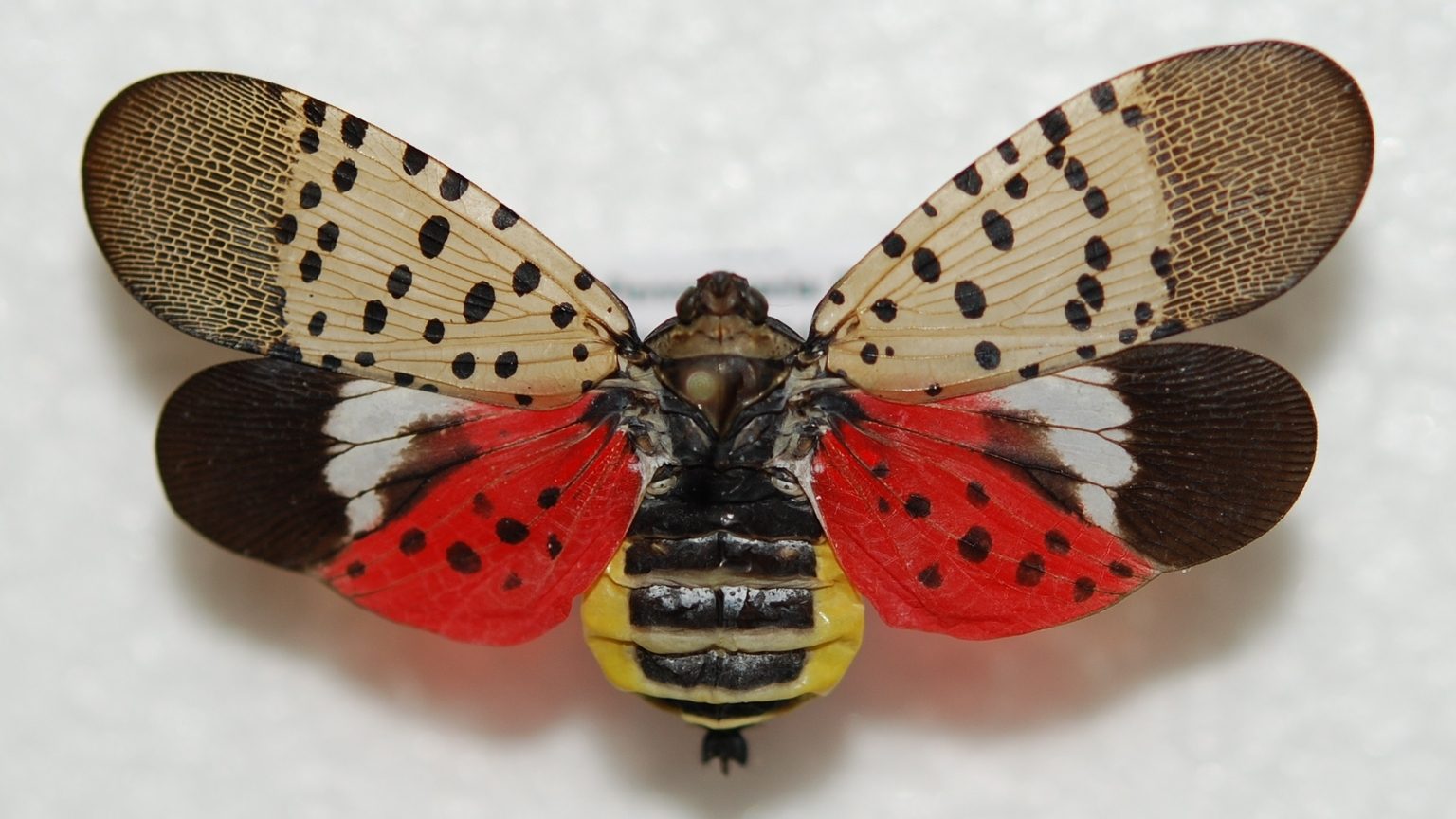The spotted lanternfly is pretty and festive-looking, with its polka-dot outer wings, red-and-black hind wings, and yellow-and-black-striped abdomen. But appearances, as they say, can be deceptive.
“This is the next bug we are all going to learn to hate,” says Rod Walker, founder and president of Blue Ridge PRISM, a nonprofit set up to help counter the flood of invasive plants and animals threatening central Virginia’s ecosystem. And the spotted lanternfly is the latest threat.
This nefarious bug was discovered in eastern Pennsylvania in 2014. Its eggs had likely hitched a ride in a pallet of rocks imported from Asia, according to Carrie Swanson, unit coordinator/extension agent with the Albemarle/Charlottesville office of the Virginia Cooperative Extension. The pest spread rapidly around Pennsylvania and into nearby Delaware and New York, wreaking havoc on forests, orchards, vineyards, and gardens. A migrant population found in Frederick County, Virginia, in January 2018 spurred Virginia’s Department of Agriculture and Consumer Services, Department of Transportation, and Cooperative Extension mobilized to set up quarantines and eradication efforts.
This past July, an alert hiker reported a lanternfly sighting along the Rivanna Trail, says Kim Biasiolli, natural resources manager for Albemarle County. VDACS found a population of between 250 and 500 insects; it treated the area in coordination with Albemarle County Parks & Recreation, and has been monitoring to make sure the infestation was cleaned up. Another sighting was reported in the Belmont area of Charlottesville, but no population was found. In the meantime, the Virginia Cooperative Extension and the Albemarle County Natural Heritage Committee have launched educational and training efforts—distributing brochures, putting out news alerts and posting on social media—to alert residents and encourage them to report any lanternfly sightings.
One part of the threat is that the spotted lanternfly is not picky—it will happily munch on any of more than 70 common plant species, damaging timber and fruit trees, and ornamental shrubs, alike. The lanternfly also likes grapevines and hops, making its appearance especially worrisome for the many wineries and breweries in the area.
The second punch is what it leaves behind: as it eats, it excretes a sticky substance biologists call “honeydew.” This substance attracts other pests, and fosters explosive growth of a common blight called black sooty mold (which looks exactly like its name). Besides being unsightly, black sooty mold weakens and can kill plants by coating the undersides of their leaves and interfering with their ability to photosynthesize.

Photo: Richard Gardner, bugwood.org
One of the spotted lanternfly’s favorite plants is the ailanthus (often called tree of heaven), another Asian species that was deliberately imported into this country in the 18th century and is highly invasive. Could the new arrival rid us of this long-established pest tree? “Unfortunately, spotted lanternflies don’t do enough damage to [kill off] ailanthus, which are really hardy and tough,” says Swanson.
Researchers are looking into biological controls, such as predators from the spotted lanternfly’s native habitat, which might work here without causing additional ecological problems. Or it may be that native species will acquire a taste for this new bug. In the meantime, says Swanson, “we can’t eradicate the spotted lanternfly, so we are trying to delay its spread.”
One of the most effective proactive measures: getting rid of ailanthus trees. Research in Pennsylvania showed that controlling ailanthus reduced spotted lanternfly egg masses by as much as 75 percent, according to Biasiolli. But killing ailanthus is no easy task—simply cutting down the tree will likely result in a wealth of sprouts off its root system. Unless the plant is small enough to by pulled up with roots intact, landowners have to use herbicides in a controlled method called “hack and squirt,” in which chemicals are squirted directly into gashes in the tree trunk.
If you want to help in this effort—either by getting trained to monitor for spotted lanternflies, or by identifying and eliminating ailanthus—you can contact the Virginia Cooperative Extension. People who own property near train tracks, interstate highways, or lots where large vehicles are stored should be especially alert, says Swanson; spotted lanternflies have been spreading by catching a ride on these modes of transportation—and disturbed soils, like those along a rail line, are places where ailanthus are likely to flourish.
As for monitoring efforts, spotting the lanternfly this time of year is a challenge. Lanternflies lay eggs in the fall and winter and then die off, leaving egg masses behind. The eggs are difficult to see on trees or rocks. But the cooperative extension has been training volunteers to set traps around stands of ailanthus, and monitor the sites as the lanternflies hatch. Nymphs will start appearing in late April to May, and go through several stages before the adult insects appear in July and August. The adults will lay eggs throughout the fall until cold weather begins.
If you do catch sight of the bug, kill it, and then tell the local cooperative extension about the sighting online or by calling (434) 872-4580. The experts say we have to be diligent, and a bit ruthless, as we practice the spotted lanternfly mantra: “See it, kill it, report it.”

